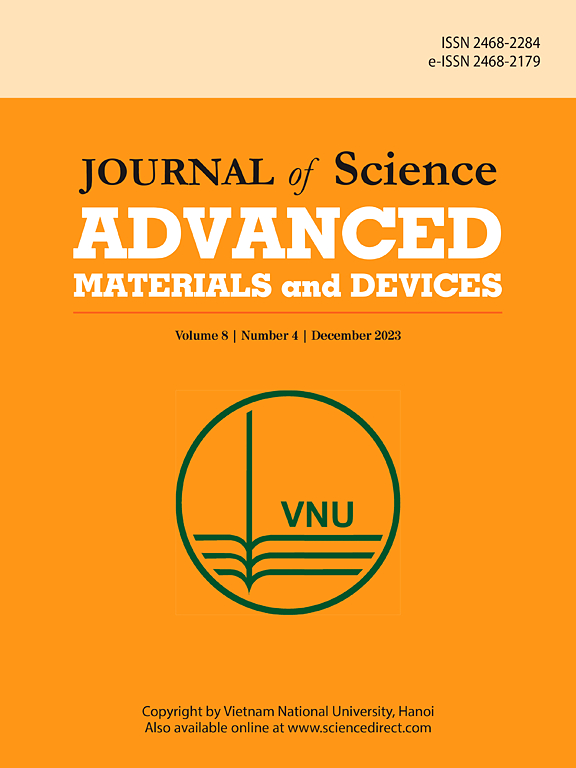可回收Y2O3-g-C3N4纳米吸附剂去除孔雀石绿染料的设计
IF 6.7
3区 材料科学
Q1 MATERIALS SCIENCE, MULTIDISCIPLINARY
Journal of Science: Advanced Materials and Devices
Pub Date : 2025-02-20
DOI:10.1016/j.jsamd.2025.100867
引用次数: 0
摘要
最近工业和农业技术的发展导致了严重的环境破坏,最明显的是水污染,考虑到人口的增加和全球饮用水源的减少,这对水安全构成了严重威胁。在这个方向上,得到了BET表面积为82.14 m2的纳米结构(Y2O3-g-C3N4)。首次将g−1作为新型吸附剂用于去除水相中孔雀石绿(MG)。此外,SEM, TEM和EDX数据验证了14.17 nm的Y2O3纳米颗粒集成到g-C3N4纳米片中。吸附实验结果符合Langmuir等温线方程,吸附mg的qmax = 1297 mg g1,动力学模型计算表明,吸附机理为单步拟二级化学反应,速率常数为0.00134 mg./mg。min,这是MG染料在Y2O3-g-C3N4纳米结构样品上的化学吸附。由于其易于制造和生态可接受的过程,Y2O3-g-C3N4纳米结构被认为是消除污染有机染料的理想和有前途的候选材料。新合成的Y2O3-g-C3N4纳米结构具有高表面积,接触时间短,去除能力强,可重复利用5次,可去除多种染料的特点,是一种潜在的有价值的废水染料吸附纳米吸附剂。本文章由计算机程序翻译,如有差异,请以英文原文为准。
Design of a recyclable Y2O3-g-C3N4 as an auspicious nanosorbent for removing malachite green dye
The recent development of industrial and agricultural technology has led to severe environmental damage, most notably water pollution, which poses a serious threat to water security, considering population increases and a decrease in global drinking water sources. In this direction, a nanostructure (Y2O3-g-C3N4) with a BET surface area of 82.14 m2. g−1 was employed for the first time as a novel sorbent to remove malachite green (MG) from the aqueous phase. Besides, the SEM, TEM, and EDX data verified the integration of 14.17 nm Y2O3 nanoparticles into the g-C3N4 nanosheets. The experimental adsorption results confirmed the best fitting to the well-known Langmuir isotherm equation, achieving qmax = 1297 mg g1 of MG uptake, and the kinetic model calculations revealed a single-step mechanism involving a pseudo-second-order chemical reaction with a rate constant of 0.00134 mg./mg. min, which accounted for the chemisorption of MG dye on the Y2O3-g-C3N4 nanostructure sample. Due to its ease of manufacture and ecologically acceptable procedure, the Y2O3-g-C3N4 nanostructure was recognized as a desirable and promising candidate for eradicating tainted organic dyes. The newly synthesized Y2O3-g-C3N4 nanostructure with a high surface area demonstrated a short contact time, outstanding removal capacity, five times recyclability, and multiple dyes elimination nominating it a potentially valuable nanosorbent for the adsorption of dyes from wastewater.
求助全文
通过发布文献求助,成功后即可免费获取论文全文。
去求助
来源期刊

Journal of Science: Advanced Materials and Devices
Materials Science-Electronic, Optical and Magnetic Materials
CiteScore
11.90
自引率
2.50%
发文量
88
审稿时长
47 days
期刊介绍:
In 1985, the Journal of Science was founded as a platform for publishing national and international research papers across various disciplines, including natural sciences, technology, social sciences, and humanities. Over the years, the journal has experienced remarkable growth in terms of quality, size, and scope. Today, it encompasses a diverse range of publications dedicated to academic research.
Considering the rapid expansion of materials science, we are pleased to introduce the Journal of Science: Advanced Materials and Devices. This new addition to our journal series offers researchers an exciting opportunity to publish their work on all aspects of materials science and technology within the esteemed Journal of Science.
With this development, we aim to revolutionize the way research in materials science is expressed and organized, further strengthening our commitment to promoting outstanding research across various scientific and technological fields.
 求助内容:
求助内容: 应助结果提醒方式:
应助结果提醒方式:


